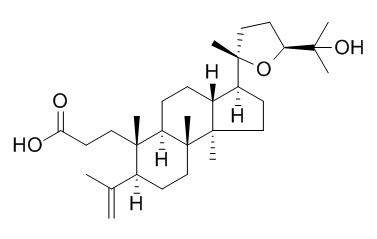Eichlerianic acid
Eichlerianic acid is a trypanocidal compound with an IC50 value of 10 mg/mL. Eichlerianic acid may have antiviral activity against Herpes simplex virus types I and II in vitro. Eichlerianic acid shows weak cytotoxicity (IC50 6.87 to >40 μM) against human cancer cell (HL-60, SMMC-7721, A-549, MCF-7 and SW480).
Inquire / Order:
manager@chemfaces.com
Technical Inquiries:
service@chemfaces.com
Tel:
+86-27-84237783
Fax:
+86-27-84254680
Address:
1 Building, No. 83, CheCheng Rd., Wuhan Economic and Technological Development Zone, Wuhan, Hubei 430056, PRC
Providing storage is as stated on the product vial and the vial is kept tightly sealed, the product can be stored for up to
24 months(2-8C).
Wherever possible, you should prepare and use solutions on the same day. However, if you need to make up stock solutions in advance, we recommend that you store the solution as aliquots in tightly sealed vials at -20C. Generally, these will be useable for up to two weeks. Before use, and prior to opening the vial we recommend that you allow your product to equilibrate to room temperature for at least 1 hour.
Need more advice on solubility, usage and handling? Please email to: service@chemfaces.com
The packaging of the product may have turned upside down during transportation, resulting in the natural compounds adhering to the neck or cap of the vial. take the vial out of its packaging and gently shake to let the compounds fall to the bottom of the vial. for liquid products, centrifuge at 200-500 RPM to gather the liquid at the bottom of the vial. try to avoid loss or contamination during handling.
Kyung Hee University2024, 4789969.
Front Immunol.2023, 14:1240800.
Plant J.2021, 107(6):1711-1723.
Molecules.2019, 24(20):3755
Korea Food Research Institute2024, 4798082
Front Immunol.2020, 11:598556.
Asian Journal of Chemistry2014, 26(8):2425
Industrial Crops and Products2017, 95:286-295
Exp Parasitol.2017, 183:160-166
New Journal of Chemistry2019, 43:12538-12547
Related and Featured Products
Nat Prod Res. 2016;30(4):433-7.
Cytotoxicity and Synergistic Effect of the Constituents from Roots of Aglaia odorata (Meliaceae).[Pubmed:
25742723]
METHODS AND RESULTS:
Twelve compounds were isolated from the roots of Aglaia odorata. Their structures were established on the basis of NMR and MS data as rocaglaol (1), rocaglamide (2), eichlerialactone (3), sapelins A (4), isofouquierone (5), Eichlerianic acid (6), shoreic acid (7), agladupol E (8), 3-epimeliantriol (9), cleomiscosins B (10), 2β,3β-dihydroxy-5α-pregnane-16-one (11) and β-d-glucopyranos-1-yl N-methylpyrrole-2-carboxylate (12).
CONCLUSIONS:
Among them, compounds 1 and 2 showed significant cytotoxicity against human cancer cell (HL-60, SMMC-7721, A-549, MCF-7 and SW480) with IC50 values of 0.007-0.095 μM, while compounds 3-5 and 10 and 11 showed moderate to no cytotoxicity (IC50 0.43 to values >40 μM). Compound 6 showed only weak cytotoxicity (IC50 6.87 to >40 μM) and its epmier 7 was completely inactivite (IC50>40 μM) in the assay. However, potent synergistic effect was observed when the molar ratio of 6 to 7 is between 4:1 and 1:1.
J Nat Prod. 1987 Jul-Aug;50(4):706-13.
In vitro antiviral activity of dammar resin triterpenoids.[Pubmed:
2828553]
METHODS AND RESULTS:
Nine triterpenes with antiviral activity against Herpes simplex virus types I and II in vitro were isolated from dammar resin. Each compound caused a significant reduction in viral cytopathic effect when Vero cells were exposed continuously to 1-10 micrograms/ml of compound for 48 h after viral challenge.
CONCLUSIONS:
The triterpenes were identified as dammaradienol [1], dammarenediol-II [2], hydroxydammarenone-I [3], ursonic acid [5], hydroxyhopanone [11], dammarenolic acid [15], shoreic acid [16], Eichlerianic acid [17], and a novel compound, hydroxyoleanonic lactone [7], on the basis of their chromatographic, spectroscopic, and physical properties.
Planta Med., 2014, 80(16).
In vitro screening of 5000 plant extracts and identification of eichlerianic acid from Cabralea canjerana (Vell.) Mart as one of its trypanocidal compound.[Reference:
WebLink]
Chagas' disease, caused by Trypanosoma cruzi, affects poor and neglected populations and remains a relevant public health concern in Latin America. The drug currently used in Brazil, Benznidazole, was introduced in the market 25 years ago, and is effective only in the acute phase of the disease [1].
METHODS AND RESULTS:
A total of 5228 crude extracts from 1243 plant specimens from Brazil were evaluated against amastigote and tripomastigote forms of T. cruzi (Tulahuen strain expressing b-galactosidase) in L929 cell line at a single concentration of 20 mg/mL. Cell infection was done with 10 trypomastigote/cell/2 hours. Two days after the infection, samples were added and incubated for 96h. The controls used were DMSO 1% and benzonidazole at 1 μg/mL [2]. One of the active samples was the ethanol extract of Cabralea canjerana (Vell.) Mart. (Meliaceae) which presented an IC50 value of 30 mg/mL and was selected for bioassay-guided fractionation. This plant is used by indigenous people to treat inflammation of the testicles, fungal infections, meningitis and diarrhea [3, 4]. The ethanol extract of the branches was obtained by maceration and it was suspended in a mixture of ethanol:water (8:2). Then, the aqueous EtOH solution was partitioned with hexane, dichloromethane, ethyl acetate, respectively. The DCM fraction, which presented an IC50 value of 15 mg/mL, was then subjected to semi-preparative RP-HPLC to yield 59 subfractions. Nineteen of these subfractions were able to reduce the replication of T. cruzi in vitro and had IC50 values ranging from 7.5 to 40 mg/mL. The most promising subfraction was chromatographed to yield Eichlerianic acid [5] with an IC50 value of 10 mg/mL.
CONCLUSIONS:
In conclusion, Eichlerianic acid was identified as a trypanocidal compound present in the extract of C. canjerana, selected in an in vitro screen using T. cruzi.



